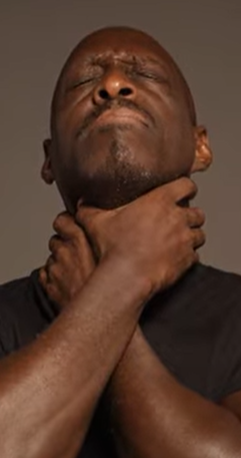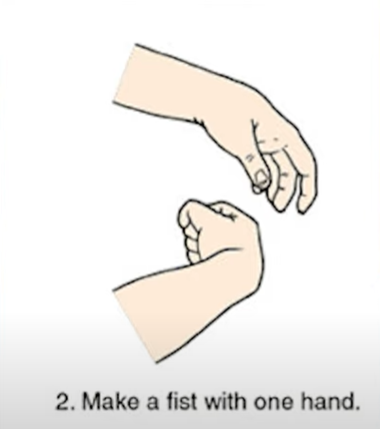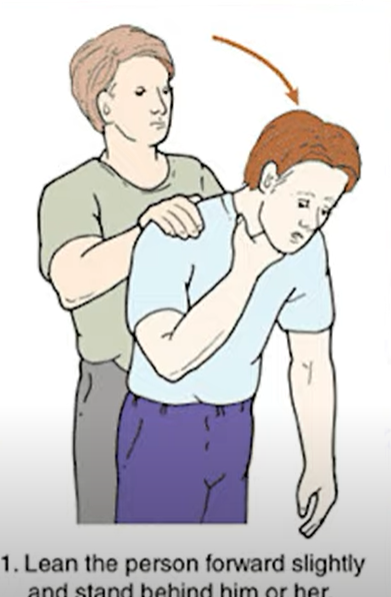Let’s suppose, you are sitting with your family and having food and suddenly something funny happens while eating, and the food goes down your wife’s throat.
She holds it by the throat and she is unable to speak, and she seems very distressed and starts turning blue. This situation is called choking.
What is Choking?
Choking occurs when something blocks the airway and prevents a person from breathing, speaking, or coughing.
CHOKING = BLOCKED AIRWAY = MEDICAL EMERGENCY
If not treated immediately, choking can lead to unconsciousness and even death.
Choking means something going through our senses and our senses stop.
CHOKING: WHEN A PERSON CAN’T SPEAK, COUGH, OR BREATHE BECAUSE SOMETHING IS BLOCKING (OBSTRUCTING) THE AIRWAY
let’s understand what you should do if someone is choking.
Different Scenario of Choking
If something got into someone’s windpipe in front of you, he might have choked. So, this depends on 2 things.
- What is the age of the person (infant, child, or adult)?
- How severe is the choking? Is it mild or severe?
Today we will know
- What to do in case of choking in children (infants) below 1 year?
- And what to do in case of choking in children above 1 year and adults?
- We will also know about mild and severe conditions in both the conditions.
That is why one has to respond promptly to choking. That is why it is important to know first of all that choking is an emergency situation.
If you do not immediately relieve a particularly severe choking, the person may die due to lack of consciousness.
CHOKING IS AN EMERGENCY
1. Choking in Children & Adults (Above 1 Year)

1. Mild Choking
Signs:
-
Can breathe (though with difficulty)
-
Can speak, cough, or make sounds
What You Should Do:
-
Stay calm and encourage them to cough forcefully
-
Call emergency services
-
Don’t attempt abdominal thrusts if they’re breathing and responsive
-
Head to the hospital as soon as possible
Always keep in mind that in mild choking if the passage is a little open then you will keep feeling breathless. That is why you should reach the hospital as quickly as possible.
2. Severe Choking in Children And Adults
What is severe choking or obstruction?
It means that the passage for breathing is completely blocked. And if there is choking, it means that the person’s breathing is stopped.
Let us know what should be done in case of severe choking in children / adults above 1 year of age?
How will you know that the person in front of you is severely choking?
A big universal sign of this is “clutching the neck”.
The person who is severely choking, his breathing stops and he immediately puts both his hands on his neck as if he is not able to breathe.
After that, that person will not be able to speak, because for speaking it is necessary to have air inflow.
That person will not even be able to cough because for coughing it is necessary for the passage to be open.
That person will not even be able to breathe. That person will start turning blue.
If any person is seen in great distress with his hand on his neck then you should understand that he has suffered severe choking. Severe choking is a life threatening emergency.
It means that the path of breathing is completely blocked and if we do not open it immediately then that person can die.
This is a very risky situation because it has happened in front of you and you are available there then what should you do? You should know this.
SEVERE CHOKING: COMPLETE BLOCKAGE OF AIRWAY, WITH NO BREATHING AT ALL. SOMEONE WHO IS CHOKING MAY BE CLUTCHING AT THEIR CHEST OR NECK AND WON’T BE ABLE TO SPEAK, BREATHE, OR COUGH
SEVERE CHOKING IS DEADLY: WITHOUT HELP THEY’LL BE EVENTUALLY BECOME UNCONSCIOUSNESS AND DIE
Demonstration: First Aid in Children and Adultism a condition of severe choking you have to give abdominal thrusts to that person.
You have to give abdominal thrusts before that person becomes unconscious, meaning you have to give them only when that person should be conscious.
How to do abdominal thrusts?
Keeping absolutely calm you do not have to put force on the chest and stomach. Where the chest/rib cage ends, there is umbilicus i.e. the nose, in between these two you have to first keep your one hand and keep the thumb part towards the inside i.e. towards the stomach.
After that you have to place your other hand on top of your first hand. Now you have to gently and forcefully press his stomach inwards and upwards with the help of both your hands.

While talking about this, always keep in mind that the person is in a life threatening emergency, he is about to die and only you can save his life. So you have to give forceful abdominal thrusts.
Till when do you have to give it?
You should keep giving these thrusts/pressure until the thing that was choking him comes out of his body or the person falls unconscious. Till then you have to keep giving abdominal thrusts continuously.
The pressure that you generate through this device, that pressure is transferred to the chest of that person and whatever is choking comes out.
This is the way to save his life, if after giving abdominal thrusts the person starts breathing, sometimes it also happens that the foreign body / thing that was choking comes out and comes in the mouth, then you take him out.
But, there is also a possibility that choking does not go away and that person would become unconscious.
There are high chances that if the person is unconscious then he would have a cardiac arrest and now you need to perform CPR, give rescue breaths.
Its method is taught in the BLS course. Always have to call for help, have to call someone else for help.
Abdominal Thrusts: Abdominal Thrusts can help save lives in such situation. do it
Immediately: Abdominal thrusts can only work before they become unconsciou
- LEAN THE PERSON FORWARD SLIGHTLY AND STAND BEHIND HIM OR HER
- STAND BEHIND THE PERSON
- WITH BALANCED FEET
- ARMS AROUND THE WAST
- TIP PERSON FORWARDFIST ABOVE NAVEL
- MAKE THE FIST WITH THE HAND
- PUT YOUR ARM AROUND THE PERSON AND GRASP YOUR FIST WITH YOUR OTHER HAND NEAR THE TOP OF THE STOMACH, JUST BELOW THE CENTER OF THE RIB CAGE”
- ARM AROUND THE WAST
- TIP PERSON FORWARD
- FIST ABOVQUICK UPWARD E NAVEL
- THRUSTS
- MAKE A QUICK, HARD MOVEMENT, INWARD AND UPWARD
IF THE PERSON BEECOMES UNCONSCIOUS, FOLLOW BLS GUIDELINES AND CALLS THE AMBULANCE/ HELP. WATCH OUR VIDEO ON HELPING IN UNCONSCIOUS STATE
Mind Choking in Infants
Come on, now we will know about mild obstruction/choking in infants (children below 1 year).
What is mild obstruction?
The breathing path is not completely closed, breathing is still going in and out.
How will you know if the child has mild obstruction?
The child will be breathing, maybe he is making some abnormal sound or thing.
The child will also be making noise or will be trying to cough or will be coughing.
If all these things are there, it means that the obstruction is not completely closed yet and the child can breathe. What should you do?
One has to reach the hospital immediately because there is always a risk that half/ partial blockage may turn into complete blockage.
Secondly, the most important thing is what should you not do?
If ever something like this happens in a child who still has partial obstruction, do not blindly insert your finger in his mouth.
Because sometimes it happens that something gets stuck on the top, half of the passage is already blocked.
You insert your finger and move it to the right and left and it goes completely inside and blocks the passage.
That is why you should never make such a mistake that you are breathing even though you are hearing a sound but do not rush to the hospital immediately.
INFANT – MILD CHOKING: IF THE AIRWAY IS ONLY PARTLY BLOCKED, INFANT MIGHT MAKE NOISE, CRY, COUGH, OR BREATHE
IF CHOKING IS MILD: REACH HOSPITAL FOR HELP, MILD CHOKING CAN LEAD TO SEVERE CHOKING
Severe Choking in Infants
Let us know what should you do in case of severe obstruction in infants (children under 1 year of age)?
What is severe obstruction?
If the complete breathing passage is blocked and the child’s breathing stops, this is a life threatening emergency.
If we do not respond immediately, then complete respiratory arrest can lead to cardiac arrest or death.
How will you find out if the obstruction is severe?
Due to complete respiratory arrest, the child will stop breathing, will not be able to cough, will not be able to cry, will not be able to utter any sound. Or you will hear a very flat, high pitched sound.
Apart from this the child may turn blue or lose consciousness.
If any of these is happening or indicates that he has severe airway obstruction, it means he is severely choked. Now you have to do something to save his life.
As we have read, children above 1 year of age have to be given abdominal thrusts.
Similarly, in children below 1 year of age, we call back blow meaning hitting the stomach and giving thrusts in the chest as back blow or chest thrusts.
Before giving back blow or chest thrusts, it is important to keep in mind that the child should be responsive.
INFANT – CHOKING: IF THE AIRWAY IS COMPLETELY BLOCKED, IT COULD BE LIFE THREATENING. IMMEDIATE RESPONSE IS REQUIRED.
NO SIGN OF BREATHING, COUGH, CRY AND LITTLE TO NO NOISE, INFANT MIGHT SEEM BLUISH & UNCONSCIOUS. CHOKING CAN BE RESOLVED IN INFANTS WITH BLACK BLOWS AMD CHEST THRUSTS
IF CHOKING IS SEVERE :IMMEDIATE ACTION IS REQUIRED TO SAVE LIFE
Demonstration: First Aid in Infants
Let’s learn step by step how to do back blow or chest thrusts.
What do you have to do first?
You have to sit somewhere, after that you have to turn the child upside down and make him lie down on the forearms of your hands.

Turning upside down means the child’s face should be towards the bottom and the back should be towards the top.
The child has to be made to lie down on the forearms of your hands, in which his face should be height wise down and his back should be height wise up.
when you lay your child down on your forearms, to keep in mind that your forearms should be supported by your thighs, place your water forearms on your legs.
While holding the child, keep this in mind very carefully that your hand which is holding the child’s face should not be applying any kind of pressure on the child’s neck or garden.
After making the child lie down in this way, in which his face is towards the bottom and body towards the top, with your other hand (which is free), you have to blow 5 times between the child’s both shoulder blades (meaning the bone of the shoulder which is prominent), with the heel pad of your free hand.
Meaning you have to hit in the forward direction so that if something else is stuck there, it comes out. We call this back blows.
After giving back blows, now shift the child to your other hand. While shifting to the other hand, his face should be upwards. Why?
Because now we are going to give him chest thrusts, so his chest should be upwards.
Keep in mind that before giving chest thrusts, his face should be downwards and body upwards.
Press the lower part of the child’s chest bone with 2 fingers of your free hand.
You have to keep in mind that we had applied pressure to the elders in the stomach but we gave thrusts on the lower part of the bone of the child which we call breast bone and with the help of our two fingers we applied pressure in upward direction.

So that if there is something it comes out upwards due to the pressure.
You have to apply pressure 5 times, if nothing comes out, and his obstruction is not relieved then you have to switch the child to the other hand, turn him over, face downward and back upward and you again have to give blows on his back.
Again give him 5 back blows. In case, if it does not come out you again switch to your other hand and continue doing so.
While switching from one hand to the other you alternatively give the child 5 back blows and 5 chest thrusts until the foreign body comes out or the child’s obstruction is relieved.
If the child becomes unconscious and stops responding completely, this indicates that the child has suffered a cardiac arrest.
Now you have to perform CPR or follow BLS guidelines and call for help.
SIT, ON A CHAIR OR ANY POSSIBLE PLACE
PUT THE INFANT FACE DOWN ON YOUR FOREARM
INFANT FACE SHOULD BE DECLINED
YOUR FOREARM MUST BE RESTING ON YOUR LAP
Whenever there is a severe obstruction or choking in front of you, whether it is a child, an adult or anyone else, you should always be careful because severe obstruction can lead to death and only you can rescue him and save his life.
Make every possible attempt to save his life.